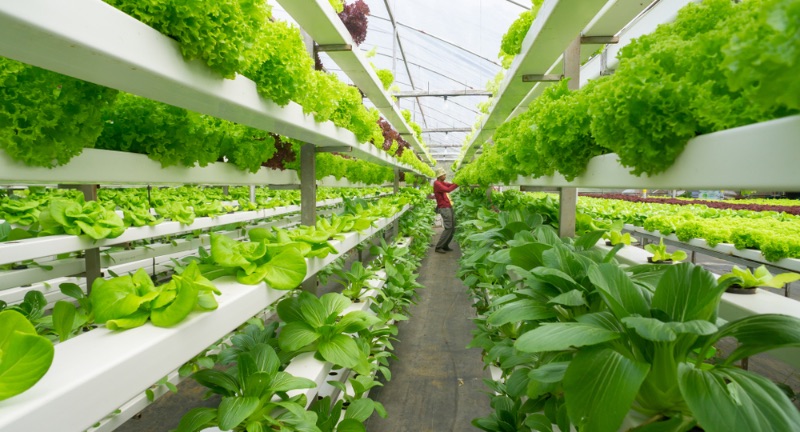ECONOMY
What Is Hydroponics, And Why Is It So Important?
Published
2 months agoon

Shutterstock
Hydroponics is rapidly becoming a crucial agricultural practice that provides a sustainable solution to many of the challenges faced by traditional farming. Growing plants without soil allows for higher yields, requires less water, and can be installed in almost any environment. With its ability to thrive in urban spaces and areas with poor soil quality, hydroponics is paving the way for the future of food production. As the demand for sustainable practices grows, hydroponics will play the most important role in feeding the global population while protecting our planet.
Conserves water

Shutterstock
Hydroponic systems use significantly less water compared to traditional soil-based farming. Water is recirculated within the system, minimizing waste and reducing overall consumption. This makes hydroponics an ideal method for regions facing water scarcity. By reducing the need for excessive irrigation, hydroponics helps conserve vital water resources for other purposes.
Maximizes crop yields

Shutterstock
Hydroponics provides optimal growing conditions, leading to higher crop yields. Since the plants have direct access to nutrients and water, they can grow faster and more efficiently. Additionally, the controlled environment allows for the manipulation of factors like light, temperature, and humidity to boost production. As a result, hydroponic farms can produce significantly more food in the same space compared to traditional farming methods.
Requires less space

Shutterstock
Hydroponics enables crop production in smaller areas than traditional farming. Vertical farming, a common hydroponic method, maximizes the use of vertical space, allowing for stacked layers of plants. This means more crops can be grown in urban spaces or areas with limited land availability. By using efficient space management, hydroponics helps address land shortages while maintaining high yields.
Eliminates soil-borne diseases

Shutterstock
Since hydroponic systems don’t use soil, they eliminate the risk of soil-borne diseases such as root rot and blight. This leads to healthier plants and reduces the need for chemical treatments or pesticides. As a result, crops grown hydroponically are often healthier and more resilient. This makes hydroponics an ideal method for organic farming or for areas where soil health is compromised.
Enables year-round growing

Shutterstock
Hydroponic systems can be operated indoors, making it possible to grow crops year-round. Temperature, humidity, and light levels can be adjusted to suit the plants’ needs, regardless of external weather conditions. This ability to control the growing environment ensures consistent production, even in regions with harsh climates. By enabling off-season growing, hydroponics provides a reliable food supply throughout the entire year.
Reduces pesticide use

Shutterstock
Hydroponic farming typically requires fewer pesticides since the closed system limits exposure to pests. The absence of soil also reduces the likelihood of certain insects and pathogens that often thrive in traditional farming. As a result, crops grown hydroponically are often cleaner and safer to consume. This not only promotes healthier food but also reduces the environmental impact of pesticide use.
Faster plant growth

Shutterstock
In hydroponic systems, plants grow faster due to the direct delivery of nutrients and water to the roots. This eliminates the need for the plant to expend energy searching for resources in the soil. The optimized growing environment also promotes stronger root systems and overall plant health. Faster growth means quicker harvests, increasing the overall productivity of the farm.
Supports urban agriculture

Shutterstock
Hydroponics is well-suited for urban agriculture because it can be implemented in small, often underutilized spaces. Rooftop farms, basements, and vacant lots can all be transformed into productive growing areas. This allows cities to produce their own food locally, reducing the reliance on imported goods. By integrating hydroponic systems into urban spaces, cities can boost food security and sustainability.
Efficient nutrient delivery

Shutterstock
In hydroponics, plants receive nutrients directly from the nutrient solution, allowing for precise control over their intake. This ensures that plants receive the exact amount of nutrients they need, avoiding deficiencies or excesses. The nutrient delivery system is highly efficient, leading to healthier plants and higher yields. This method reduces the waste of nutrients and ensures more effective growth.
Low environmental impact

Shutterstock
Hydroponics has a relatively low environmental impact compared to traditional farming methods. It requires fewer chemicals, reduces water consumption, and minimizes soil degradation. Additionally, since it can be practiced locally, it reduces the need for long-distance transportation of food. This makes hydroponics an environmentally friendly and sustainable choice for modern agriculture.
Reduces land degradation

Shutterstock
Hydroponics reduces land degradation by not relying on soil for crop production. Traditional farming methods often lead to soil erosion, nutrient depletion, and overuse of chemicals, contributing to land degradation. By growing plants without soil, hydroponics helps preserve land resources and prevent environmental damage. This also makes it a valuable tool for regenerative agriculture practices.
Allows for precise control of conditions

Shutterstock
Hydroponic farming systems allow for precise control over environmental factors like light, temperature, and humidity. This creates the ideal conditions for plant growth, improving overall efficiency. By adjusting these variables, farmers can optimize crop production for different types of plants. This control also helps mitigate the risks associated with unpredictable weather or pest infestations.
Minimizes waste production

Shutterstock
Hydroponic systems are designed to minimize waste by recycling water and nutrients. The water used in the system is constantly filtered and reused, preventing unnecessary wastage. Additionally, plant byproducts and materials used in hydroponic systems can often be repurposed or recycled. This closed-loop system helps reduce the environmental impact of farming while maximizing resource use.
Adaptable to climate change

Shutterstock
Hydroponics offers a resilient solution to the challenges posed by climate change. By controlling the growing environment, it is possible to grow crops in areas affected by extreme temperatures or unpredictable weather. This adaptability ensures that food production can continue even in regions with challenging climates. Hydroponics can provide a stable food supply, despite the disruptions caused by climate change.
Enhances food security

Shutterstock
By providing a reliable method for local food production, hydroponics enhances food security. It reduces dependence on imports and allows communities to grow their own food, even in urban areas. Hydroponic systems can be scaled up or down, making them suitable for both small-scale home growing and large-scale commercial farms. This flexibility ensures that food security can be achieved in a variety of locations.
Can grow in non-arable areas

Shutterstock
Hydroponics allows for farming in areas where traditional agriculture may not be possible. Arid regions, deserts, or urban environments without fertile soil can all be used for crop production. By growing plants without soil, hydroponics overcomes the limitations of land quality. This opens up new opportunities for agriculture in locations where growing food was previously not feasible.
Supports vertical farming

Shutterstock
Hydroponics is a key enabler of vertical farming, which uses stacked layers of plants to maximize space. By growing plants in vertical columns, it is possible to produce large quantities of food in small footprints. Vertical farming with hydroponics is particularly well-suited for urban environments where space is limited. It allows for efficient food production in areas that would otherwise be unsuitable for traditional farming.
Reduces transportation costs

Shutterstock
By enabling local food production, hydroponics reduces the need for long-distance transportation of agricultural products. This not only lowers transportation costs but also reduces the carbon footprint associated with food distribution. Local food production helps create more resilient food systems, reducing dependence on global supply chains. As food is grown closer to where it is consumed, it also stays fresher for longer.
Promotes sustainable agriculture

Shutterstock
Hydroponics promotes sustainable farming by reducing the need for large amounts of land, water, and chemicals. It uses fewer resources and can produce more food with less environmental impact. Since it does not rely on soil, hydroponics also avoids the degradation of land through overuse. This makes it a crucial tool in moving towards more sustainable agricultural practices.
Lowers carbon footprint

Shutterstock
Hydroponic systems have a lower carbon footprint compared to traditional farming methods. By reducing the need for transport, soil tilling, and pesticide use, hydroponics helps cut down on greenhouse gas emissions. Furthermore, many hydroponic farms utilize renewable energy sources, further reducing their environmental impact. This makes hydroponics an attractive option for environmentally conscious food production.
Provides higher-quality produce

Shutterstock
Crops grown in hydroponic systems often have superior quality compared to those grown in soil. The controlled environment ensures optimal growing conditions, leading to better taste, texture, and appearance. Since hydroponics reduces the need for pesticides and chemicals, the produce is also cleaner and healthier. This results in higher-quality food that is more appealing to consumers.
Easy integration with technology

Shutterstock
Hydroponics is highly compatible with modern technologies, including automation, sensors, and data analytics. Automated systems can manage watering, lighting, and nutrient delivery, making it easier for farmers to maintain optimal conditions. Integration with sensors and IoT devices allows for real-time monitoring of plant health and environmental conditions. This makes hydroponics a smart, efficient, and data-driven farming method.
Scalable for home and commercial use

Shutterstock
Hydroponic systems can be easily scaled up or down to suit different needs, from home gardens to large commercial farms. Small systems can be set up in homes, schools, or community centers to grow food on a smaller scale. For larger-scale operations, hydroponics can be expanded to support significant commercial food production. This flexibility makes hydroponics a versatile solution for various levels of food production.
Reduces dependency on fertile soil

Shutterstock
Hydroponics reduces reliance on fertile soil by growing plants without the need for traditional soil. This is particularly valuable in regions where soil quality is poor or where arable land is scarce. By using water and nutrient solutions instead of soil, hydroponics bypasses many of the challenges associated with soil depletion. This allows for productive agriculture in areas where conventional farming would be unfeasible.
Shortens supply chains

Shutterstock
Hydroponics helps shorten food supply chains by enabling local production of fresh crops. As crops can be grown close to the point of consumption, transportation times are reduced, leading to fresher food. Shorter supply chains also lower the environmental impact of food distribution. By producing food locally, communities are better equipped to meet their own food needs without relying on distant suppliers.
Ensures consistent crop production

Shutterstock
One of the key benefits of hydroponics is the ability to ensure consistent crop production throughout the year. Since the growing environment can be fully controlled, factors like weather or seasonal changes do not affect plant growth. This consistent production leads to a steady supply of food, reducing the risk of food shortages. By mitigating the impacts of external factors, hydroponics helps maintain a reliable food source.
Conclusion

Shutterstock
Hydroponics is transforming the future of agriculture. To put it simply, hydroponics is the way to maximize resources and produce food in an efficient and sustainable way. As this technology continues to evolve, hydroponics has the potential to revolutionize food production. Whether on rooftops in urban areas or in areas with poor soil quality, hydroponics is making it possible to grow food where it was once impossible. Hydroponics is the future.
Related Topics:

More From Lifestylogy
-


26 Dirtiest Jobs In The World, Would You Brave One…
-


To Buy or Not to Buy? The Realities of Homeownership
-


The Long History Of Cheese
-


24 Uses For Bananas That Are Oddly Practical
-


Why You Should Throw Out Your Cleaning Products
-


20 Things People Mindlessly Spend Their Money On That Might…
-


27 Habits To Implement That Could Change Your Life For…
-


Hardwood Is The Best: Here’s Why
-


22 State Laws That Are Hard To Believe They Actually…